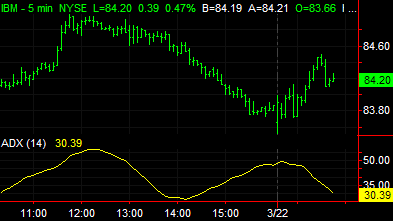Analysis Techniques & Strategies

| Name | Expression | Default | Description |
| Length | Numeric | 14 | Number of bars to use in the calculation of ADX. |
| TriggerLevel | Numeric | 20 | Alert trigger level when alerts are enabled. |
| AboveTrigColor | Numeric | Yellow | Plot color when ADX is above trigger level and UsePlotColoring is true. |
| BelowTrigColor | Numeric | Red | Plot Color when ADX is below trigger level and UsePlotColoring is true. |
| EqualTrigColor | Numeric | Cyan | Plot color when cDX is at the trigger level and UsePlotColoring is true. |
The ADX measures the strength of a prevailing trend as well as whether movement exists in the market. A low ADX value (generally less than 20) can indicate a non-trending market with low volatility whereas a cross above 20 may indicate the start of a trend (either up or down). If the ADX is over 40 and begins to fall, it can indicate the slowdown of a current trend. This indicator can also be used to identify non-trending markets, or a deterioration of an ongoing trend. Although market direction is important in its calculation, the ADX is not a directional indicator.
| Number | Name | Default Color | Description |
| Plot 1 | ADX | Yellow | Plots the ADX as a line. |